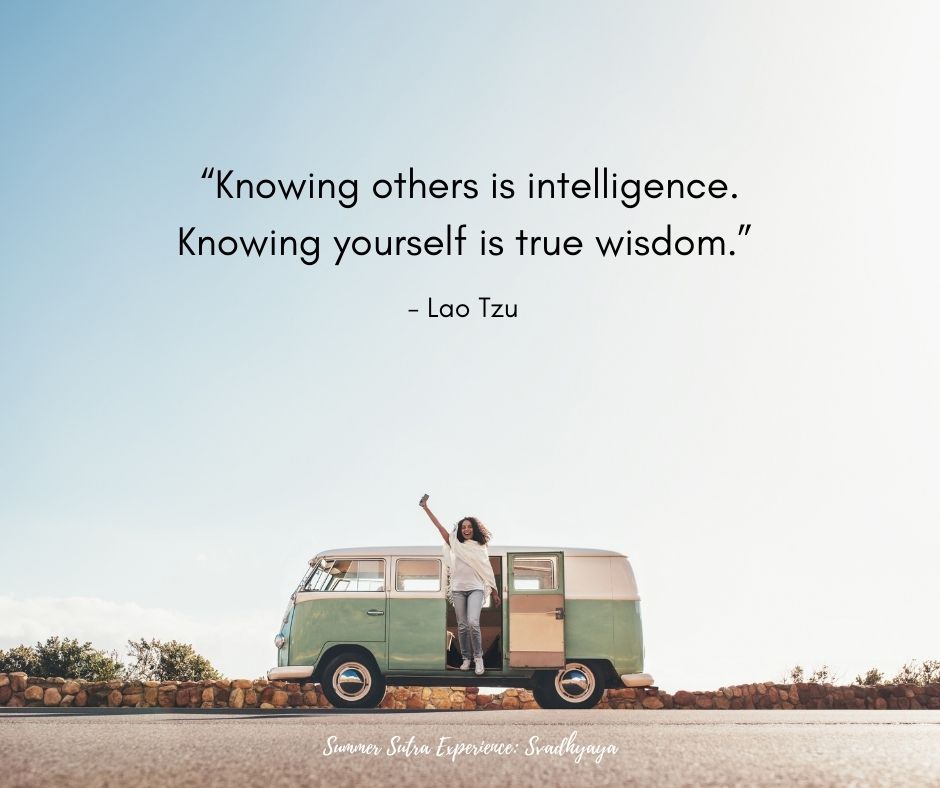SSE Week 11: Svadhyaya
Introduction to Svadhyaya
This week, we’re focusing on one of my absolute favorite yogic principles, svadhyaya, or study by and of oneself. Why do I love it so much? Well, self-study has allowed me to unequivocally put the practices of the yamas and niyamas in place, and to notice and experience real change in myself — in the way I move about and engage with the world around me, and within me. To me, there is no greater gift that yoga has given me than my ability to engage in self-study and self-inquiry.
To be clear, it’s not always easy; in fact, it very rarely is. But as Nicolai Bachman states in The Path of the Yoga Sutras, “Learning about ourselves and our relationship to the outside world can provide us with a glimpse of who we are.” He goes on to say, “We may or may not like what we discover.” We must be brave enough to take that risk, though, because the outcome is worth it:
Looking at ourselves insightfully brings us awareness of our strengths and shortcomings. Once we understand where we are, we can set an intention to let go of our negative qualities and reinforce those that have a positive effect. Svadhyaya includes understanding our physical, mental, and emotional bodies; our actions and impressions (karma-s); and the world around us[.…] During the practice of self-observation, we can ponder what causes us and those around us suffering by asking ourselves: In what situations do I react, and why? How much of my response is automatic, controlled by my past (raga and dvesa)? What are my habitual tendencies (samskara-s)? How do my actions or reactions affect the outcomes? How can I convert negative outcomes to positive outcomes?
These are truly powerful questions and practices, and the wealth of insight and information gained through the implementation of svadhyaya is innumerable. Bachman finishes by reiterating,
Through svadhyaya it is possible to understand anything about ourselves. Self-observation is the key to understanding who we truly are. When followed through (tapas) with faith and humility (isvara-pranidhana), self-observation gives us the power to convert old, harmful behavior into new, helpful action. The ultimate goal is complete self-knowledge, with the realization that we are a changing outer shell surrounding a pure, unchanging, inner light of awareness.
Home Exercise: Svadhyaya
An important aspect of practicing svadhyaya is the study of mantra and text. Classically, this niyama meant dedication and devotion to memorizing sacred texts and spiritual incantations which connect us to those texts and divinities. This week, take some time to sit in stillness; see if a mantra or affirmation or intention comes up for you (a prayer, a positive statement, or a pure wish).
Focus on your breath, try to release distractions as they come, and don’t force it! Give yourself the space and quietude needed to tune into your pure inner knowing, your heart-mind, and see what comes up. Don’t get discouraged if nothing appears on your first go; it may take several attempts for your inner knowing to feel comfortable and safe enough to emerge.
When you have something, write it down! Then, research books, articles, podcasts, lectures, ANYTHING relating to it, and get studying. Document your experience in a journal or voice memo, and build from there.
“The ultimate goal is complete self-knowledge, with the realization that we are a changing outer shell surrounding a pure, unchanging, inner light of awareness.”
– The Path of the Yoga Sutras
Watch this Week’s Video
Bring Svadhyaya into Practice

Sharable image for Facebook

Sharable image for Instagram
Practice: All Levels Yoga
Practice: Gentle Yoga
2020-08.19_Gentle-Svadhyaya from be the love on Vimeo.
